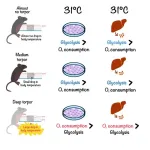(Press-News.org) August 17, 2023—(BRONX, NY)—Researchers at Albert Einstein College of Medicine have found that the virus responsible for chikungunya fever can spread directly from cell to cell—perhaps solving the longstanding mystery of how the virus, now emerging as a major health threat, can manage to escape antibodies circulating in the bloodstream. The findings, published today in Nature Microbiology, could help in developing effective vaccines or treatments for chikungunya fever, a debilitating and increasingly common mosquito-borne disease.
A Possible Explanation for Prolonged Infections
“Previously, chikungunya virus was thought to spread in the body by infecting a cell, replicating within that cell, and then sending new copies of the virus into the bloodstream that then infect new cells,” said study leader Margaret Kielian, Ph.D., professor of cell biology and the Samuel H. Golding Chair in Microbiology at Einstein. “However, we’ve found that the virus can also hijack a host cell’s cytoskeleton—the proteins that support cells and maintain their shape. The virus causes the infected cell to send out long thin extensions that make contact with uninfected neighboring cells, enabling the virus to safely and efficiently travel from one cell to another.”
Dr. Kielian and her colleagues have named these virus-induced structures intercellular long extensions, or ILEs. “This mode of viral transmission may not only shield some copies of the virus from the host’s immune response, but it may also explain why symptoms of chikungunya infection can persist for many months or years,” added first author Peiqi Yin, Ph.D., a postdoctoral fellow in Dr. Kielian’s lab.
In addition to fever, chikungunya infections often lead to chronic and debilitating arthritis. The virus is spread to humans by the bite of infected mosquitoes, which become infected by feeding on people who already have the virus. Over the past 15 years, chikungunya virus has become an important and increasingly widespread human pathogen. Multiple outbreaks have caused millions of human infections in numerous areas including the Americas, Africa, Asia, Europe, and the Caribbean. The National Institute of Allergy and Infectious Diseases lists chikungunya virus as a Category B Pathogen, the second-highest priority for organisms posing threats to national security and public health.
Confirming a Cell Structure’s Role
Dr. Kielian and colleagues discovered the presence of ILEs in chikungunya-infected cells several years ago, but it wasn’t clear whether the structures facilitated cell-to-cell viral transmission. The study described in the Nature Microbiology paper was designed to answer that question.
The first part of the study involved the use of cultured mouse cells. The researchers exposed the cells to chikungunya virus that expressed a fluorescent reporter protein, allowing them to observe that infectious virus particles were indeed being transmitted from cell to cell via ILEs. Cell-to-cell transmission occurred even in the presence of high quantities of neutralizing antibodies that were added to the culture medium.
To confirm this mode of cell-to-cell transmission in living animals, the researchers studied chikungunya infection in mice. Mice that were first inoculated with neutralizing antibodies and were then directly injected with chikungunya virus did not become infected. However, antibody-treated mice that were then injected with virus-infected cells (rather than just the virus) did develop chikungunya infections that were resistant to the neutralizing antibodies.
“Together, these studies show that ILEs shield chikungunya virus from neutralizing antibodies and promote intercellular virus transmission, both in vitro and in vivo,” said Dr. Yin. The mouse studies were conducted by Thomas E. Morrison, Ph.D., and his group at the University of Colorado School of Medicine in Aurora.
Short-Circuiting the Connections
In a final set of studies, the researchers determined that certain antiviral antibodies were able to block ILEs from forming and to prevent cell-to-cell transmission. “If we can generate the production of such antibodies in human patients, or develop other methods to stop ILE formation, that could be especially helpful in combatting the chronic symptoms of chikungunya infection,” said Dr. Kielian. “We’re currently studying different ways to do this.”
The study is titled “Chikungunya virus cell-to-cell transmission is mediated by intercellular extensions in vitro and in vivo.” Other Einstein authors were Jonathan R. Lai, Ph.D., M.D./Ph.D. student Karen Tong, and Judy J. Wan, Ph.D. Other contributors include Bennett J. Davenport, Ph.D., and Ph.D. student Brian C. Ware at the University of Colorado School of Medicine, Aurora, CO; Michael S. Diamond, M.D., Ph.D., and Arthur S. Kim, Ph.D., at Washington University School of Medicine, Saint Louis, MO; Thérèse Couderc, Ph.D., at Institut Pasteur, Université de Paris, Paris, France; and Marc Lecuit, M.D., Ph.D., at Institut Pasteur, Université de Paris, and Necker-Enfants Malades University Hospital, APHP, Institut Imagine, Paris, France.
The research was supported by grants from the National Institutes of Health (R01GM057454, R01AI141436, R01AI125462 and R01AI143673) and by an NCI Cancer Center Support Grant (P30CA013330).
Competing interests: Dr. Lai is a paid consultant for Celdara Medical, LLC. Dr. Diamond is a consultant for Inbios, Vir Biotechnology, Senda Biosciences, Ocugen, Moderna, and Immunome. The Diamond laboratory has received unrelated funding support in sponsored research agreements from Vir Biotechnology, Moderna, Generate Biomedicine, and Emergent BioSolutions. The other authors declare no competing interests.
***
About Albert Einstein College of Medicine
Albert Einstein College of Medicine is one of the nation’s premier centers for research, medical education and clinical investigation. During the 2022-23 academic year, Einstein is home to 740 M.D. students, 194 Ph.D. students, 118 students in the combined M.D./Ph.D. program, and approximately 225 postdoctoral research fellows. The College of Medicine has more than 1,900 full-time faculty members located on the main campus and at its clinical affiliates. In 2022, Einstein received more than $202 million in awards from the National Institutes of Health. This includes the funding of major research centers at Einstein in cancer, aging, intellectual development disorders, diabetes, clinical and translational research, liver disease, and AIDS. Other areas where the College of Medicine is concentrating its efforts include developmental brain research, neuroscience, cardiac disease, and initiatives to reduce and eliminate ethnic and racial health disparities. Its partnership with Montefiore, the University Hospital and academic medical center for Einstein, advances clinical and translational research to accelerate the pace at which new discoveries become the treatments and therapies that benefit patients. For more information, please visit einsteinmed.edu, follow us on Twitter, Facebook, Instagram, LinkedIn, and view us on YouTube.
END
A research team co-led by UCLA investigators has shown that an immunotherapy drug combination can be an effective second-line therapy for patients with an aggressive and deadly type of melanoma that is resistant to the widely used immunotherapy drugs known as PD-1 inhibitors.
In clinical trials, the investigators found that the combination therapy can extend the amount of time patients live without their cancer worsening, known as progression-free survival, and helps overcome resistance to prior immunotherapies, allowing more patients to benefit from the treatment.
The ...
Researchers led by Genshiro Sunagawa at the RIKEN Center for Biosystems Dynamics Research (BDR) in Japan have shown that an animal’s stem cells possess the same level of cold resistance as the animal itself. Published August 17 in Cell Reports, the study focuses on mice with different hibernation-like characteristics, showing that those with the best resistance to cold temperatures have stems cells that generate energy differently than others. Beyond these immediate findings, the study establishes mouse stem cells as a practical model ...
To control our behaviour, the brain must be able to form associations. This involves, for example, associating a neutral external stimulus with a consequence following the stimulus (e.g., the hotplate glows red - you can burn your hand). In this way, the brain learns what the implication of our handling of the first stimulus are. Associative learning is the basis for forming neural connections and gives stimuli their motivational force. It is essentially controlled by a brain region called the dopaminergic midbrain. This region ...
About The Study: In this survey study, the primary care physician vision testing rate was low and differed by insurance status among persons ages 3 to 17. Despite recommendations of yearly testing for children ages 3 to 5, less than half of those with private insurance received testing, with lower rates among those without private insurance.
Authors: Olivia J. Killeen, M.D., of the University of Michigan in Ann Arbor, is the corresponding author.
To access the embargoed study: Visit our For The Media website at this link https://media.jamanetwork.com/
(doi:10.1001/jamaophthalmol.2023.3644)
Editor’s Note: Please see the article for additional ...
About The Study: In this randomized clinical trial that included 95 patients, a preoperative walkthrough of a patient’s day of surgery using augmented reality decreased preoperative anxiety compared with traditional perioperative education and handouts, but there was no significant effect on postoperative anxiety, pain levels, or narcotic use. These findings suggest that augmented reality may serve as an effective means of decreasing preoperative patient anxiety.
Authors: Michael G. Rizzo Jr., M.D., of the University of Miami, is the corresponding author.
To ...
To continue reducing the costs of solar energy and other clean energy technologies, scientists and engineers will likely need to focus, at least in part, on improving technology features that are not based on hardware, according to MIT researchers. They describe this finding and the mechanisms behind it in Nature Energy.
While the cost of installing a solar energy system has dropped by more than 99 percent since 1980, this new analysis shows that “soft technology” features, such as the codified permitting practices, supply chain management techniques, and system design processes that go into deploying a solar energy plant, contributed only 10 to 15 percent of total ...
Québec City, August 17, 2023 – A large-scale international collaborative study lead by Professor Jacques Simard from Université Laval and Professor Douglas Easton at the University of Cambridge, UK, has identified new genes associated with breast cancer that could eventually be included in tests to identify women at increased risk.
Current genetic tests for breast cancer only consider a few genes, such as BRCA1, BRCA2, and PALB2. However, these only explain a minority of the genetic risk, suggesting that more genes remain to be identified.
The study found evidence for at least four new breast cancer risk genes, with suggestive evidence for many others. ...
In a new study, researchers at the Department of Biochemistry, Indian Institute of Science (IISc), have used a novel imaging technique to pinpoint how strongly adjacent bases – the building blocks of DNA – stack up on top of each other in a single strand. The findings open up possibilities for building complex DNA nanodevices and unravelling fundamental aspects of DNA structure.
Behind the seamless running of every living cell lies DNA – the hereditary vehicle carrying information for its growth, functioning and reproduction. Each DNA strand is usually made up of four nucleotide bases – Adenine (A), Guanine (G), Thymine (T) and Cytosine ...
The simple view of reading (SVR) is a widely accepted theory that attempts to define the skills that contribute to early reading comprehension. It attributes a person’s reading comprehension ability to two skills—word recognition (decoding) and language comprehension. This theory has been tested in the context of second as well as foreign languages. However, SVR is known to have some limitations, especially for complex reading, such as second and foreign language (SFL). Recent reading research indicates that SVR needs to be expanded upon to include cognitive factors which may have an ...
TAMPA, Fla. — The Center for Immunization and Infection Research in Cancer at Moffitt Cancer Center is expanding its viral infection research in Africa. The cancer center has received a $5.5 million, five-year specialized research center grant (U54CA277834) from the National Cancer Institute to investigate virus-associated tumors that disproportionately impact men and women living with HIV in sub-Saharan Africa.
Two-thirds of people living with HIV call sub-Saharan Africa home. Their immunosuppression from the virus that causes AIDS leaves them susceptible to infections that cause cancer and makes it more difficult to control viral infections, such as human papillomavirus ...


